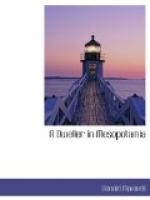Brown would have none of this. Anything is anathema to Brown which destroys topographical romance. He is a fierce enemy to “higher criticism,” which does away with the whale in the book of Jonah or the snow-clad summit of Mount Ararat as the resting-place of the ark. It is quite exciting, he maintains, to picture the ark stuck on the perilous ice-peaks of a glacier, with Noah and his family endeavouring to get the elephants and giraffes safely down a ravine like the Mer de Glace to the more temperate regions of the plains below. How much better than thinking of it stuck fast on some wretched mound by the Euphrates, 30 feet high.
[Illustration: AN OLD WORLD CRAFT, A TYPE OF BOAT UNCHANGED SINCE THE DAYS OF SINBAD]
[Illustration: Tower of Babel (Fig. 3).]
Here was a find, too good to be lost, a high tower on a mound visible from afar and unrivalled by any equally picturesque claimant. It looked the part splendidly, so the Tower of Babel it should be as far as Brown was concerned.
As a matter of fact, Brown “let himself go” with historical speculations and discovered not only that this was the Tower of Babel, but that it was the site of Nebuchadnezzar’s fiery furnace, with evident signs, from a fragment of calcined brick, which he bore away in triumph, that it had been heated seven times hotter on some occasion.
We climbed about the ruin, unearthed several coins, which seemed quite plentiful in one place where the rain had washed down the side of a small mound, and found obvious signs of some great conflagration. Brown says that, as no one has got any better explanation of this fire than he has, he will stick to his furnace theory.
The native driver turned up all right with the car and took us back to Hillah. From there we crossed the river by the bridge of boats and at a distance of about five miles came upon the scene of the great excavations, which, although the city is said to have extended over an area of some 200 square miles, is generally known as the site of Babylon. It was in 1899, that the German archaeologist, Dr. Koldeway, began excavations on a large scale and with systematic care.
Although Babylon was a site occupied by some city in prehistoric times, as stone and flint implements denote, the earliest houses of which there are any traces belong to about 2000 B.C. It was Nebuchadnezzar, however (605—562 B.C.), who rebuilt the city and made it very splendid, and it is to this period of his reign that the greater part of the ruins of the great city belong. The mound Babil is thought to be the palace of Nebuchadnezzar II. An inscription reads: “On the brick wall towards the north my heart inspired me to build a palace for the protecting of Babylon. I built there a palace, like the palace of Babylon, of brick and bitumen.”
[Illustration: BELLAMS UNDER SAIL]




